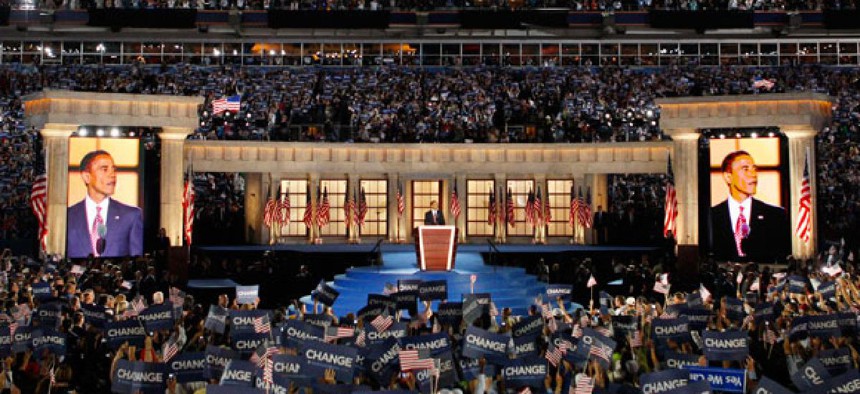
Ron Edmonds/AP file photo
Why the modern political convention still matters
Millions of voters make their decision during the conventions.
At 181 years old, the national party convention is showing its age. But despite the guaranteed attacks from those who yearn for the old days of floor fights, multiple ballots, and delegates stampeded by rousing rhetoric, the modern convention is hanging in there, still playing a pivotal role in presidential campaigns. Surprisingly, when Republicans raise the gavel on their convention in Tampa, Fla., on Aug. 27 they will be opening what could be the four most important days of Mitt Romney’s fall campaign.
This is true even though the Tampa convention will be just a shadow of what these gatherings used to be. There hasn’t been a fistfight on the floor since 1952 when delegates for Robert Taft and Dwight Eisenhower slugged it out in Chicago. There hasn’t been a multi-ballot nomination battle since that same year, when it took three ballots for Democrat Adlai Stevenson to put away Estes Kefauver. And there has been no real suspense about a vice presidential nomination since 1956 when Stevenson unexpectedly left the decision up to the delegates.
But what Romney’s Republicans will have--and what President Obama’s Democrats will have when they open their convention four days later in Charlotte, N.C.--is something unimagined when those 116 delegates gathered in Baltimore in 1831 at the first national party convention, picking William W. Wirt to run as the nominee of the Anti-Masonic Party. Romney and Obama will have a huge television audience and their last real chance to present a largely unfiltered message to undecided voters.
The importance of the conventions is clear from research conducted over the last six decades by the American National Election Studies, a collaboration of the University of Michigan and Stanford University. After every election since 1948, ANES has asked voters when they made their choice. Most voters either “knew all along” or settled on their candidate the day he announced. But for millions of voters, the decision is made during the conventions. In recent elections, the number hit a high at the 29 percent who decided during the conventions in 1988. That year, 51 percent decided during the convention or right afterward. ANES has not yet released its numbers for 2008, but in 2004, 14 percent of the electorate made up their mind at the conventions.
That means that 18.1 million voters decided their votes at the time of the 2004 conventions and 26.3 million decided then in 1988.
This is no surprise to veteran campaign strategists, and it is why they work so hard to try to script and control every minute of the convention. Tad Devine is a veteran of six Democratic conventions, working for five candidates, as a delegate tracker for Jimmy Carter in 1980, a deputy delegate director for Walter Mondale in 1984, a floor manager for Michael Dukakis in 1988, as well as playing key roles for Al Gore in 2000 and John Kerry in 2004. “I’ve seen it,” Devine told National Journal. “I know it is a hugely important moment in the campaign, just as important as one of the debates. I saw that with Gore in 2000. We went into the convention trailing by 17 points. And by the time we left Los Angeles, Gore was 5 points ahead.... So 22 million people changed their mind in a week.”
He recalls similar movement for Dukakis after his acceptance speech in Atlanta. Years later, that speech is criticized for his declaration that the election “isn’t about ideology, it’s about competence.” But Devine said that the speech’s emphasis on jobs and the economy was what viewers heard, and it propelled Dukakis to a big lead in the polls before Dukakis ceded the stage to Republicans at their convention.
This is possible because millions of Americans who have shunned the campaign the whole year tune in for the key moments of the conventions. “That’s what makes the convention critically important,” said Cal Jillson, a political-science professor at Southern Methodist University who has studied conventions. “So many Americans are not yet watching. Even though we junkies have been riveted for a year and think that we have as much information as we can stand about these guys, a good half of the public is just about to start paying attention. They don’t yet have a clear idea, particularly of Romney and [Paul] Ryan.” Additionally, he told NJ, “independents want to hear Obama make his case again.”
Jillson does expect future conventions to be shorter than four days, although host cities are reluctant to take on the costs and security challenges for anything shorter. In that regard, this year’s Democratic convention may offer a glimpse of the future--the first day will see no convention business, just a celebration of North Carolina.
The conventions have come a long way on TV since the 1948 convention was aired live on four networks (NBC, Dumont, ABC, and CBS) to just 18 stations in nine cities. Now, conventions are the most watched political events except for the fall debates. And the numbers keep growing. In 2008, more people watched the speeches by Obama, John McCain, and Sarah Palin than watched the Olympics opening ceremony in Beijing, the finale of “American Idol,” or the Academy Awards that year.
McCain’s acceptance address was seen by 38.9 million viewers, according to Nielsen, just slightly above the 38.4 million who watched Obama’s speech. And Palin had 37.2 million viewers for hers. Combined, Nielsen reported that McCain and Palin had 76.2 million viewers and Obama and Joe Biden had 62.4 million. And the actual numbers were even higher because Nielsen does not count all the networks that aired the speeches.
The very size of these audiences, ironically, has combined with the move to primaries to drain the conventions of their drama. The Founders never thought the public would have much to do with picking presidents. They expected most presidents to be selected by the House of Representatives after the Electoral College deadlocked. But, instead, nominees were picked by congressional caucuses--“King Caucus”--until 1824. Then brokered conventions had their day, from 1832 to 1968. That ushered in the modern era of primaries doing what conventions used to do. In 1960, John F. Kennedy had to face only two contested primaries. That was up to 10 in 1968. But Romney this year had to maneuver through 38 primaries and 13 caucus states. It doesn’t leave much for his convention.
Republicans were the first to understand the evolution from nominating fight to TV show. Ron Walker, GOP convention manager in 1984 and an organizer at seven different conventions, helped Republicans write a minute-by-minute script for Miami in 1972. “We scripted that thing down to a gnat’s ass,” he boasted. But Democrats were slower to catch on. In an interview in 1996, Robert Strauss said that it was not until 1974, when he was Democratic National Committee chairman, that he “came to the decision that this was purely ... a television show.” He called it a turning point for the party when he interviewed the top ad agencies in New York “to find myself a television producer” for the next convention.
Today, there is no question the production is smoother, certainly since the days of that first televised convention in Philadelphia. Convention organizers that year, wanting to cast Democrats as the party of peace, got the bright idea of putting boxes of live doves on stage until the right moment when they would be released to dramatically and majestically flutter skyward. Unfortunately, they didn’t comprehend the intense heat of those early television lights. When the right moment arrived, the doves were released. Half already were dead. Those still clinging to life staggered upward only to die when they hit the hot lights, their bodies falling on the delegates. Others, in a final release, relieved themselves, soiling the heads of many delegates--including the bald head of Minority Leader Sam Rayburn who could be heard cursing.
Modern-day planners aren’t likely to let that happen again. But just think of the ratings.







